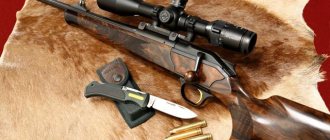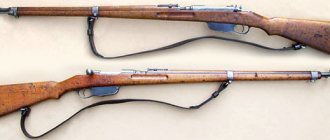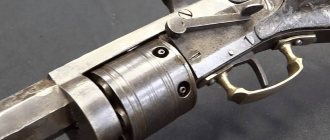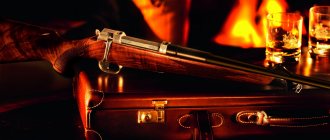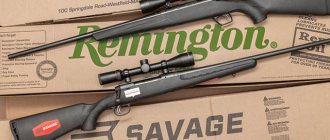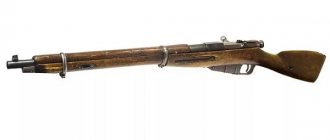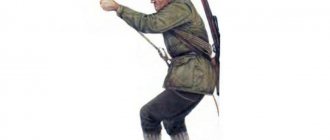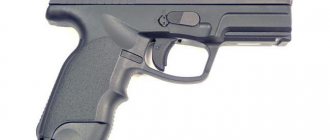MAKSIMOV.SU
“At regimental reviews, this colonel loved to talk with the soldiers and always asked them the same question: why are the rifles introduced in the Austro-Hungarian army called “Mannlicherovka”?
In the regiment they spoke about him with ridicule: “Well, he’s ruined his manlicherovin!” (c) Jaroslav Hasek, “The Adventures of the Good Soldier Schweik.”
Mannlicher family M86-90
I pick up a fine and miniature carbine from Austria at the end of the 19th century with some trepidation.
And a bunch of associations from old Soviet books and films immediately come to mind: I remembered the immortal soldier Svejk J. Hasek and the glorious junior policeman Grishchenko from the story “The Green Van” by Alexander Kozachinsky.
Mannlicher rifles
M90, 93, 95, 95-24
Popular characters
related to "Mannlicher". Perhaps - model 1895, which we will assume in the future. But in our case, something else is interesting - one of the carbines illustrating this article is united by the design of the bolt group with the Mannlichers of Schweik and Grishchenko. But the cartridge is used on the specimen that came into my hands... Russian three-line!
Alpine marksmen (jaegers) with M95 Stutzen
According to popular belief,
The Mannlicher M95 repeating rifle was adopted by the Austro-Hungarian army in 1895. In fact, the stutzen was adopted in 1895, and the rifle only on November 22, 1896.
Rifle designer
was the Austrian gunsmith Ferdinand Ritter Von Mannlicher, an employee of the state arms factory in the city of Steyr.
Caliber
- 8x50R (M93) and, since 1930 - 8x56R (M30). Loading is batch. Magazine capacity – 5 rounds. The rifle barrel length is 765 mm, after modernization in 1930 - 480 mm, weight - 3.8 kg. Let us immediately note that the modernization of 1930 concerned only the cartridge, and the shortening of the rifles was carried out constantly.
Alpine marksmen (jaegers)
with M95 Stutzen
New – well forgotten old?
Imported hunting rifles
with a “straight-action” shutter are no longer exotic. The Blaser R93 has long become almost commonplace in mid-range hunting circles. After the appearance of the “93rd”, very little time passed and rifles of similar designs from various European arms companies, both well-known and not so well-known, poured into our market.
In information materials
There is a lot of talk about this weapon about some revolutionary design elements, but the emphasis is on the dramatic increase in rate of fire relative to traditional bolt action rifles.
A separate question
There is the somewhat strange fact of attempts to compete in the rate of fire of modern Western “straight-shooters” with semi-automatic weapons and their active promotion to the Russian market, especially against the backdrop of the imposed Western concept of “one (royal) shot.”
Double standards
or is it just such sophisticated marketing? Probably both. But we have what we have and each hunter has the right to independently understand his preferences. And in this article, let's remember the ancestor of all modern rifles with a “straight” bolt - the unique and very interesting Mannlicher system and trace its evolution within the framework of a magazine article.
Especially
that in
the previous article
we had a conversation about the Swiss “straight walkers”, which, in my opinion, are inferior in all respects to the more advanced and battle-tested Mannlichers.
M90 Kar
Mannlicher_Gewehr
Mannlicher M95
Our hunters
we have been familiar with the “straight” bolt of long-barreled firearms for a long time and first-hand - after the First World War and the Civil War, many Mannlicher rifles remained on the territory of Russia, and Canadian Ross rifles, which were structurally very similar to them, were also often encountered.
M95 & M95-30
Used
These rifles were in Soviet Russia for quite a long time, but their time ended at the same time as the original cartridges. In the 20-30s. In the 20th century, the time has come to drill out the barrels of foreign military weapons for small, smooth calibers. To this day, you can find fully functional “frolovkas” based on these systems.
M95 Carbine & Stutzen
Then the Russian forest people
for a long time he used (and now actively uses again) three-line guns and Mausers, which remained in abundance on the territory of the European part of Russia after the Second World War.
We forgot about the “upright moves” of Mannlicher and Ross (we didn’t really know about the Swiss Schmidt-Rubin system). M95 Repetiergewehr
And so
We again see “straight-up guns” on the shelves of our hunting stores, but in a modern guise and under the guise of revolutionary achievements of science and technology. However, otherwise the new product cannot be sold, and in practice the same “Blazer” turned out to be an excellent weapon.
Mannlicher rifle M95
But let's return to the subject of our article.
So, Mannlicher M95.
Legendary rifle, from 1895 to 1918. released in various modifications in a huge circulation of more than 3.5 million copies (the very design of the “straight-action” bolt was used by Mannlicher in a rifle model 1885 - this is a completely different bolt, although also “straight-action”). Loading the K93
While
The rifle was distinguished by an original and unusual design, which allowed the weapon to be reloaded by simply moving the bolt handle back and forth. The use of burst (rather than clip-on) loading completed the difference between the M95 and its “classmates” of that time.
Specialists,
incl.
Russians, at the beginning of the 20th century, spoke very positively about this system. The successful use of Mannlichers during the First World War and in a number of less significant conflicts was also taken into account. The grandfather of Nikolai Pavlov (the author of a number of photographs for this article, which is on a green background), a Bulgarian by origin, went through both the Balkan and the First World Wars with the Mannlicher, and recalls the operational characteristics of this rifle without any negativity. Loading M90
Some sources
They mention such shortcomings of the Mannlicher design as increased force on the bolt handle when reloading, the complexity of assembling the bolt and the sensitivity of the system to contamination. But Pavlov’s grandfathers had no such complaints. Dismantling of the bolts was carried out only under the supervision of sergeants and officers and only on command.
Loading the M95
Yes, Fedorov,
in his book “In Search of Weapons” he directly writes about the fairly high reliability of these weapons: “Inspecting rifles in combat conditions forced me to change my views on some long-known truths in the weapons business. This happened, for example, with the Austrian rifles of the Mannlicher system.
In my time,
Based on purely theoretical considerations, we believed that this rifle had a very significant drawback: its magazine had an open window through which dust and dirt could enter the feed mechanism. […] Meanwhile, comparing Russian and Austrian rifles in the trenches, I came to exactly the opposite conclusion. Dust and dirt that got into the Russian rifle magazine during loading accumulated there, since there was no way out for them. And in the Austrian one, precisely thanks to the window, dust and dirt fell out.”
Loading the M95-24
Another important point:
the Mannlicher rifle used a flanged cartridge, very similar to our three-line (7.62x54R). Here Nikolai Pavlov draws our attention to the fact that, on the contrary, the Russian cartridge is similar to the Austrian one, because it is completely copied from it, and even the caliber of the first cartridges for the Mosin rifle was 3.15 lines (8 mm), that is, exactly like the M.88 .
Unfortunately
, I do not have any documents on hand that can confirm or refute this point of view. Nikolay relies on Western sources (it must be admitted that a huge amount of specialized literature for collectors and weapons enthusiasts is published abroad) and the possibility of direct comparison of cartridges.
Valves M90, 93, 95, 95-24,
top view
On the other side,
There is a confirmed fact of the use of cartridges of his own authorship in 3.15 line caliber back in 1886 in N. Rogovtsev’s rifle. There is a widespread version that the 8-mm cartridge for the French Lebel M1886 rifle was used as the basis for the development of the Russian three-line cartridge.
But further
something happened that confirms Pavlov’s opinion: the Commission for the development of a repeating rifle, chaired by Chagin, compared in 1889 the rifle of the L. Nagan we know with the Mannlicher rifle mod. 1888, she preferred the Austrian 8x50R ammunition for further work on the domestic cartridge.
The emergence of the Russian rifle cartridge
was preceded by long and labor-intensive work, and it was developed almost simultaneously with the rifle itself. And the cartridge became a three-line cartridge in 1890, when the development of a three-line barrel was completed. Then there was the well-known epic of choosing a rifle, which was adopted for service on April 16, 1891, along with a cartridge and clip.
So
we can really consider the ammunition for the Mannlicher rifle mod. 1888, the ancestor of our cartridge, but taking into account a number of design and technological factors that categorically do not allow us to claim blind copying.
Valves M90, 93, 95, 95-24,
bottom view
However,
here it’s not even a matter of visual similarity, but of the sleeve flange.
After all, both “they” and we love to scold our rifle cartridge, forgetting that at the turn of the 19th and 20th centuries, the flanged rifle cartridge was in service with the weakest armies of England, France, Austria-Hungary and... Russia. During World War II, Western flanged cartridges also fought and fought successfully. Complete disassembly of the M95 rifle bolt
Please note
– in the West, no one reproaches their gunsmiths for choosing an “outdated” or “wrong” cartridge. And in general, they have their own history - a “sacred cow”. We are still big fans of once again, with or without cause, pouring dirt on our ancestors and our history. It's high time to think about this.
Complete disassembly of
the M95 rifle bolt
You can argue a lot
about the advantages and disadvantages of burst loading, but the simplest comparison will be this: a Mosin rifle can be loaded both from a clip and “one at a time.” This is impossible with the Mannlicher M95 - only in a pack. What if you have ammo, but no pack? Shoot with loading “one at a time”, like from Berdan-2?
Complete disassembly of
the M95 rifle bolt
Maybe,
that is why some of the Mannlichers in the 1920s. when re-barrelled for the German cartridge, it was converted to use a standard rifle clip, with the introduction of a pack into the design, tightly riveted in the magazine shaft.
Complete disassembly of the M95 rifle bolt
But in my opinion
It seems much more interesting that there is a Mannlicher carbine chambered for our cartridge in nature. The very fact of re-barreling rifles for different ammunition is by no means a sensation, but, in our case, this supposedly conceals one of the secrets of the Civil War. According to legend, some of the captured M95s were re-barreled at the Sestroretsk plant for the Russian 7.62 mm rifle cartridge.
Illustrating
In this article, the carbine would fit well under this version, but there is a discrepancy - it has the letter S stamped on the breech, there is no liner, the barrel is shortened and the sights are changed. And this suggests that this is the 1930 modification. After all, it was this year that Austria adopted a more powerful, in comparison with 8x50R, modified cartridge 8x56R. Almost all the old M95s were converted to it, receiving a shortened barrel and a new sight.
P86, 88, 93 & 30 cartridges
So
One can only guess in which country and when this carbine was re-barreled, although for us this is not important. Judging by the state of the mechanics and the bore, it had a very small shot. The carbine itself has undergone an arsenal overhaul, or rather a cosmetic update, so its “new” appearance is nothing more than familiar to domestic shooters and hunters from the very fresh-looking hunting modifications from Mosin’s three-line rifles.
Cartridges in packs P86, 88, 93 & 30
Shooting
from a Mannlicher carbine mod.
1895 History by history,
and shooting is always much more interesting and allows many controversial issues to be clarified in practice. So, we go to the shooting range and take up a shooting position. We fill a pack with cartridges. With considerable effort we open the shutter. An unusual action, already familiar from the Schmidt-Rubin rifle. The hand just reaches out to lift the handle up, but you have to pull strictly towards yourself.
Cartridge pack
"Manlichera" has a marked top, where a large notch is stamped. The pack is pushed into the magazine until it clicks. All that remains is to send the bolt forward - the upper cartridge is sent into the chamber of the barrel. That's it, the weapon is loaded and ready to fire. When the bolt is open, the carbine can be instantly discharged: just press the button on the inside of the trigger guard, after which the feeder will cheerfully and loudly knock the pack up, just catch it.
Mannlicher carbine in comparison
with Mosin sniper rifle mod. 1891/30
Safety lever
located on the left side, directly on the shutter. The fuse operating algorithm is intuitive; switching positions does not cause any difficulties. Although V.E. Markevich at one time seriously criticized the M95 fuse. Indeed, it would be more logical to locate the safety on the right side of the bolt group.
But also
English "Lee-Enfield" safety lever is located on the left and is even less convenient! But both the Austrians and the British have always been by no means in last place in the weapons world. Why they designed rifles with such an inconvenient safety lock for their weapons is a mystery to me personally.
Shooting from a Mannlicher carbine. On the firing line
We have
they like to criticize the safety of the Russian three-ruler, solving the problem of weak fingers by welding a ring like the same Schmidt-Rubin rifle and other intricate methods. Try other military weapons of that time in your work - you will want to criticize foreign rifles.
Gate.
If a kind soul does not tell you in advance how to at least insert the removed bolt into the receiver (the bolt is removed after pressing the trigger forward), it may not work right away. Not to mention completely disassembling the shutter. Its assembly, without the use of auxiliary tools (at least a coin), is difficult.
Recharge
Our rifle was not easy to use, especially if you were not used to it. Apparently, the operation of the mechanism could be made easier by polishing the “guts” of the bolt and the lugs. Probably, many years of use of rifles led to the same result.
Here once again
I’ll quote N. Stanev’s words: “Grandfather never complained about Mannlicher’s complexity or his reliability. The rifle always worked. My aunt's father-in-law fought in WWI against the Russians and Romanians on the dusty plains of Romania and in the sands off the Black Sea coast. His only complaint was related to the lack of a bayonet on the carbines (his grandfather served as a cavalryman) and in hand-to-hand combat he had to fight back only with the butt.
Before the start of WWI
M.95 carbines did not have a bayonet mount, unlike guns and rifles. My grandfather fought in the south during the Balkan War and came all the way to Odrin, where there is as much dirt as you want. In WWI he fought in Serbia, where there was also plenty of snow and mud.” In my opinion, this opinion sounds quite comprehensive and, taking into account the above quote from Fedorov, authoritative.
If we evaluate
operation of the Mannlicher bolt from the standpoint of biomechanics, then pulling the blown cartridge case out of the chamber in one “toward” movement is much more difficult than with preliminary release of the cartridge case by turning the bolt handle upward, as on rifles with a conventional “bolt”. But, we must admit that this system is really very interesting, both from a constructive and historical point of view, and in terms of practical application in hunting.
Descent on our carbine
turned out to be disgusting. When the trigger was pressed, the shutter trigger clearly “moved” vertically; the force needed to be applied to release it was quite serious. And so on almost all military rifles in the world (information for those who like to criticize the Mosin three-ruler trigger).
Fuse operation
An entourage frame sight in its archaic style
Our Mannlicher carbine is typical for all rifles of the late 19th and early 20th centuries. In the lowered position of the frame, we get a firing distance of up to 500 steps - almost like with the permanent sight “P” on the AK-74. We raise the frame - yeah, the bottom slot allows you to shoot only 300 steps.
We need to go even further
– we understand the slider up. The slots on the sight are triangular, and so is the front sight. Not the most ideal geometry for a sight: shooting with such sights requires good vision. But what can you do – it’s authentic.
The same hole
in the bottom of the M95 magazine
The shot is loud.
The flash is the size of a barrel. But when shooting at 300 meters, standing, hand-held, with this “short gun” I confidently hit standard chest and height targets. No accuracy tests were carried out, but it is unlikely that the carbine shoots worse than 2 MOA.
When sending
After the last cartridge, an empty pack silently falls out of the lower window of the store. The M95 magazine, due to its features, has been causing active controversy for the second hundred years, but we have already discussed this issue in some detail above. Again, the M95 system has gone through more than one war and this is the only way it has proven its reliability.
Shooting
from the Mannlicher M95 carbine
Certainly,
and this argument can be considered controversial, because the history of weapons knows many cases of persistent use by armies of weapons that do not meet the requirements of the military. We also know that war is economics and politics. And these things often do not fit well with the ideals and demands of the military. But I seriously doubt that this can be attributed to Mannlicher rifles.
Shooting
from the Mannlicher M95 carbine
conclusions
Mannlicher design rifles
(we are talking about any model and modification) are worthy exhibits in any collection. The “Mannlicher” topic is truly immense; a lot of books have been written on it abroad. For us, this rifle is still a desirable exotic. Therefore, it would be easier and more correct for me to draw conclusions based on the carbine that fell into my hands.
Considering
the minimal dimensions and weight of the carbine, its excellent adaptability and excellent weight distribution, combined with a powerful (inexpensive and widespread) rifle cartridge and potentially good rate of fire, this M95 is a noteworthy example of a hunting weapon.
In any case, this little guy allows you to confidently take the first accurate shot. Soldiers with M95 Stutzen
In conditions
, where this may be sufficient, it is unlikely that anyone will not appreciate the advantages of this carbine. Moreover, on a long walking hunt. Of course, the Mosin carbine mod. 1938 or 1944 is no worse (and the price is 20-30 times cheaper), but what to do if you have a Mannlicherovina, and even chambered for a three-line cartridge?
I repeat,
but the M95 carbine (like any Mannlicher rifle) is also interesting as a historical example, and this is also important. Not to mention the pleasure you get simply from leisurely shooting from the weapons of the junior policeman Grishchenko and the brave soldier Schweik!
Ranger team
with M95 carbines
The article was published in the magazine “MasterRuzhye”, No. 11 for 2015 (No. 224)
Scout rifle: one for all occasions
PHOTO RENTON/FLICKR.COM (CC BY-NC 2.0)
It is believed that the concept of the Scout rifle was put forward by the famous American shooter Jeff Cooper in the early 80s of the last century.
He proposed the idea of a universal rifle, as they say, for all occasions.
According to his ideas, a rifle should be suitable for both hunting and self-defense, while it can be light, compact, convenient and, as follows from the above, the first, and possibly the only, rifle in a hunter’s life.
In our country, such thoughts have never been voiced, although we have long had weapons that quite aspire to the place occupied by Scout rifles in the USA and Europe.
For example, we have a well-developed niche for semi-automatic weapons, and it is on this that designers can easily build a domestic Scout rifle.
So let's look at what we have. Cooper expressed the basic requirements for the new weapon in several postulates.
WEIGHT
The weight of the rifle should not exceed 3.5 kg, while its length is limited to one meter. According to Cooper, such a rifle is compact enough for self-defense and suitable for hunting. According to this criterion, our Mosin carbine and SKS are suitable for the role of a rifle.
| Long focal length sights are also available on carbines with a Henry brace. PHOTO BROWN ALERT/FLICKR.COM (CC BY 2.0) |
Both are compact and convenient, and if we use a plastic stock instead of wood, we will almost meet the weight restrictions.
CALIBER
The caliber of the Scout rifle was strictly limited by Cooper: only .308, no other options were offered. This is understandable, the .308 is the most versatile caliber, suitable for hunting almost any game found in the United States, if, of course, the shooter knows how to shoot locally.
We must not forget that this caliber is in service with the US Army, which makes it possible to buy inexpensive cartridges for target practice.
It is interesting that all these arguments apply to the .30-06 Springfield caliber, so it would be logical to include it in the calibers for Scout rifles, but, apparently, due to the size of the case, which is slightly longer, Cooper did not recognize it quite suitable.
The fact is that an increase in the cartridge will inevitably lead to an increase in the bolt group of the rifle, and consequently, the weight of the weapon will also increase.
In relation to our conditions, the most suitable cartridge for the Scout rifle would be 7.62x54R, which is very close in characteristics to .308, but is more common in our country and is in service with the army.
| Steyer specially created a model of the Scout rifle. PHOTO JINKZ/FLICKR.COM (CC BY-SA 2.0) |
As an alternative, consider our most popular and inexpensive cartridge, the 7.62x39. Although many, including our legislators, consider it not powerful enough, if it can shoot, it is quite suitable for catching food, and, most importantly, it is affordable.
On its basis, it is possible to develop a lightweight and turning carbine in the “Scout” concept.
BOLT OR SEMI-AUTOMATIC?
The operating principle of the Scout carbine was based on the use of a longitudinally sliding bolt with manual reloading. This is a very interesting point, because Cooper himself was calm about semi-automatic rifles, but insisted that a survival carbine should be simple, reliable and trouble-free.
We can agree with him, since in the USA there are not many semi-automatics in .308 caliber that can boast of high reliability and at the same time fall into the category of at least up to four kilograms.
Therefore, the Americans have no choice; only a “bolt” with manual reloading can be light and reliable. In addition, Cooper planned the weapon as inexpensive and accessible, but, as practice has shown, this hope was not justified.
| The Mosin rifle can also be equipped with a long-focus sight. PHOTO WIKIMEDIA.ORG (CC BY 3.0) |
Our situation is somewhat different. After the Mosin rifle, all the efforts of designers and industry were thrown into creating reliable and simple semi-automatic and automatic weapons, which is why in our version the Scout rifle is seen as a semi-automatic weapon.
Ideally, it would be an SKS chambered for the .308 cartridge, but, as I noted above, 7.62x39 is not bad either.
ACCURACY REQUIREMENTS
Cooper established a completely acceptable accuracy of fire - 2MOA (if converted into our usual values, this is approximately 60 mm per 100 m).
This accuracy is sufficient for hunting at a distance of up to 200 meters or for hitting a chest figure at 300–350 m, both with optics and with open sights.
According to this parameter, almost any of our weapons meets Cooper’s requirements (provided that they are not indecently confused), although our army standards for them are somewhat worse.
OPTICS
The last point (but not the last for the rifle itself) we will look at the optical sight, which was proposed (and this is the most unusual thing in this rifle) to be installed at a great distance from the eye.
Of course, if you install a regular sight like this, it will be impossible to use it: for Scout rifles, sights with a long focal length are used, usually these are installed on pistols.
| Ruger offered his own version of the Scout rifle - the Gunsite Scout Rifle. PHOTO RENTON/FLICKR.COM (CC BY-NC 2.0) |
The concept of such sights was developed in Germany during World War II. A weapon with such a sight can be quickly aimed at a target, the sight practically does not block the field of view, and several targets can be quickly hit.
You can quickly work on targets located at different distances from the shooter. This arrangement facilitates quick and correct insertion and eliminates injury from the scope, which can happen even to experienced shooters.
In addition, if the rifle allows you to equip a magazine from a clip, then this function is preserved when installing a scope with a long focus.
There is one more feature: for some weapon models in which the cartridge case is extracted upward (for example, our SKS), the classic arrangement of the optics causes problems.
The cartridges hit the sight and sometimes fly back, interfering with the operation of the reloading mechanism. But with the Scout this does not happen precisely because the sight is moved forward.
Typically, 1-4x scopes are installed on Scout rifles, which is most convenient. With a 1, the sight works like a collimator; with a 4, you can see the target and it is more convenient to shoot locally in calm conditions, when there is enough time to shoot.
In addition, the rifle was conceptually designed to shoot at a maximum of 200 meters, and for such distances a 4x magnification is more than enough.
Sometimes higher magnifications, for example, 2–7x, are installed on a Scout rifle, but high magnifications are not very convenient on sights that are located far from the eyes.
The fact that the sight can be quickly removed, and, if possible, installed while maintaining zeroing, is an important function of the rifle, while the presence of open sights is mandatory, which is unusual for American hunting rifles.
Everything is clear here: after all, a survival weapon must remain working, even if the sight is damaged.
| The forward sight makes loading and unloading the rifle easier. PHOTO RENTON/FLICKR.COM (CC BY-NC 2.0) |
For the domestic weapons school this is not a problem at all. In the concept of our weapon, open sights should be available for use even with an optical sight installed, although in recent years this approach has been abandoned in favor of keeping the optics as low as possible.
Is it good or bad? As always, there are pros and cons to any decision. But if you're going to be shooting out to 200 meters, the fit of the optic isn't that important.
Several years ago there was an attempt to bring to Russia a series of inexpensive “Sturman” optical sights with a long focus.
The purpose of this was to give shooters the opportunity to use such optics in practice. Unfortunately, this attempt did not receive much response, primarily because at that time there were no appropriate brackets and experience in installing them.
| Many consider the Scout to be an excellent hunting rifle. PHOTO TERRY GLAMPER |
In addition, according to the author’s plan, a belt for hand-held shooting should have been attached to the Scout rifle, but it should also be possible to install a bipod and, as an option, a spare magazine placed on the weapon.
WHAT IS THE RESULT?
What has practice shown? Practice has recognized that the concept of a rifle has a right to exist, that such a universal rifle is convenient for the stated purposes.
But not a single manufacturer has been able to provide shooters with an inexpensive rifle that meets all the requirements. Steyer made an excellent Scout rifle: a plastic stock, a sight mounted far in front, a spare magazine in the butt and even a bipod integrated into the forend, and finally, a modern design - everything is great. Everything except the price.
In its basic configuration, the rifle costs $1,500–1,800 (for comparison, a regular Remington 700 costs about $400).
But Cooper’s idea initially envisioned an inexpensive rifle. Rueger, Savage and even Mossberg offered their own versions of the Scout, but they were unable to make a weapon under $700.
Perhaps the name of the inventor, Jeff Cooper, played a cruel joke in pricing: “Scout” has become a brand, and a branded rifle cannot be cheap.
So what's the bottom line? In the USA there are many adherents of the Scout rifle, but it did not become widespread, and most importantly, it did not become the first rifle for the shooter, as planned, a rifle that introduces the world of weapons, shooting and hunting.
Many shooters build their own Scout by taking a regular, off-the-shelf, inexpensive rifle, often used, and fitting it to the parameters put forward by Cooper.
What do we have? Today, any rifle from the USA is very expensive. As I wrote, the most suitable and versatile caliber for us is 7.62x54R, but the choice is not that great. This is a Mosin carbine, close to one meter in length, or a short version of the Tiger carbine.
I think that given our high culture of semi-automatic production (I say this without any irony), we should not abandon them.
"Tiger" is heavy, but this is not its only disadvantage; installing a sight with a long focus will take a lot of brainpower, but if the shooter can handle it, he will get an excellent carbine for all occasions with enormous firepower.
It's easier with a Mosin carbine. If we knock out two transverse pins from the rear sight and move it forward, we are surprised to find that it is attached to a completely standard dovetail bar, which will accept any rings of this format.
All that remains is to find a long-focus scope and, if desired, change the stock to a lighter and more elegant plastic one. The resulting carbine meets almost all the requirements of the Scout rifle concept. I think that in our conditions this is the most interesting option.
I think the concept of the Scout rifle is very interesting and original. It is ideal for the role of a first rifle or a non-specialized weapon, which is stored just in case and for all occasions.
For those who love guns and can afford to have several units, the Cooper rifle can be one of many.
In addition, our laws do not allow you to buy a rifled carbine without experience in owning a smoothbore gun, and defending yourself with one is not very correct from the point of view of the same law.
For self-defense, it is better to buy a shotgun, it will be the first hunting rifle, but for survival it is much better to take the civilian version of the AK. So rifles built according to Jeff Cooper’s concept are unlikely to become widespread on our soil.
Alexander Kudryashov November 19, 2022 at 12:08
